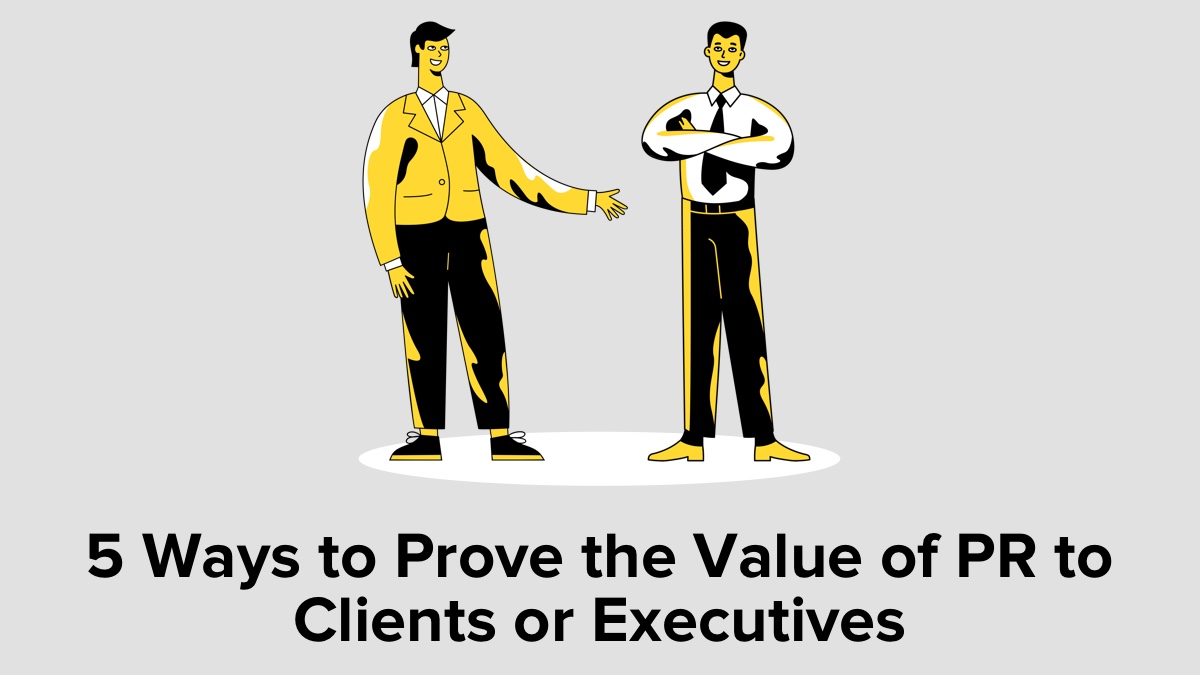5 Ways to Prove the Value of PR to Clients or Executives

PR is one of the few departments that still have a tough time quantifying results. Executives or clients might ask, “Well, how did this PR campaign perform?” And for some PR pros that’s a tough question to answer when tools and capabilities that help them understand are not at their disposal. Other times, PRos are left wondering if their hard work and efforts are noticed and appreciated especially when you consider the amount of time it takes to secure a placement with a well-known news publication.
While some PRos are familiar with metrics like SOV (share of voice) or include UTMs (urchin tracking module) to identify conversions through links, there are still many unanswered questions that we, as PR professionals, must understand and accurately answer when asked upon. So, I took to Twitter and asked my PR network, “How do you prove the value of PR to clients or executives?”
How do you prove the value of PR to clients? Executives? #prrequest
— 🤙 Jered Martin 🤙 (@JmoMonk) January 26, 2021
Below are responses from 5 PR and marketing professionals who work closely with clients and executives and can accurately prove PR is worth the time and investment.
One of the first answers came from Shama Hyder. She says:
⬆️ Mindshare = 💰Marketshare. Just look at Tesla and Salesforce.
— Shama Hyder (@Shama) January 26, 2021
What’s interesting here is that she mentions Salesforce and Tesla, two very notable companies that most consumers and business professionals are aware of. Elon’s tweets have now replaced his PR team but still, they garner thousands of engagements within a mere few hours.
For companies like Salesforce, especially during COVID, they’ve become a major player in their initiatives to help combat COVID and have even helped create a cloud-specific vaccine registration platform.
For Jen Mcginley, she says:
When a client gets targeted earned media, connects and speaks with their ideal audience the momentum builds and so does traction. You can see and feel the shift. They are gaining authority, visibility and credibility.
— JLMStrCommunications (@jenlmcginley16) January 26, 2021
Her point is something we’re also very familiar with at OnePitch. We’ve seen massive uptakes in traffic and conversions as a direct result of earned media placements. And, as I mentioned above, if you can quantify your results then there’s a direct correlation that’s easily viewed.
For Krystyna Coyle, it’s all about ESOV (excess share of voice):
Field and Binet talk about ESOV. There’s some good data /charts on that.
— KrystynaCoyle (@KrystynaCoyle) January 26, 2021
If you’re unfamiliar with ESOV, here is a quick explainer from the popular SEO tool, Ahrefs.
Jeremy Hurst says:
Set and agree clearly defined Key Performance Indicators, then monitor and analyse the results on an ongoing basis throughout the campaign, regularly discuss the data with the client in an open and transparent way, and then adjust the campaign as necessary.
— Jeremy Hurst (@JeremyHurstUK) January 26, 2021
This mirrors a similar philosophy we outlined in our Essential Guide of Public Relations. Setting clear KPIs from the start allows you to effectively track your campaign successes and thus relay them back to the team. If you want to know 5 relatively important PR KPIs to consider tracking, read this post we recently shared.
Lastly, here is what Nathaly Santa Maria had to say about proving the value of PR:
I try to focus on impact #s and data visualization. You invested in this campaign and it improved retention, sales, etc. Considering what an attorney costs when there is a crisis, too, it saves a brand money and time to proactively invest in their reputation and message.
— Nathalie Santa Maria, APR (@sunnysidenate) January 26, 2021
Not only does she focus on numbers but she also backs them up with visualizations. This is important to note because let’s be honest, most of us don’t want to interpret findings off a spreadsheet.
________
If there is one thing you can take away from this post it’s that there’s no “standard” for tracking PR and MR (media relations) campaigns. You MUST determine what metrics and KPIs you want to follow and you MUST accurately measure them in order to convey the true impact PR has on your brand or client.
For more tips, tricks, and industry insights make sure to follow OnePItch on Twitter and subscribe to our monthly newsletter.
Want more blogs like this?
Click below to subscribe to our newsletter and receive emails with the top blogs from The TypeBar!
